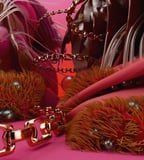NFTs Are Fashion's Newest Collectibles

By now you've probably heard the term NFT, but maybe you're not entirely sure what it's all about? Or what those three letters even stand for? NFTs, or non-fungible tokens, are a kind of digital contract that verifies ownership of something. NFTs can be "attached" to digital assets like art or fashion, and allow them to be sold or transferred. When NFTs are sold, the creator of that asset receives commissions from every sale, creating a new marketplace for brands and artists to make money off of their digital designs. (In some cases a lot of it.) In March, a piece of digital artwork by Beeple was sold at Christie's in an online auction for a whopping $69.3 million.
Luxury design houses quickly took notice of the potential of NFTs, and in the past few months Gucci auctioned off an NFT inspired by its fall/winter 2021 collection in an online auction hosted by Christie's, Burberry launched an exclusive line of digital accessories for Blankos Block Party, and Dolce & Gabbana generated $6.1 million in sales in its auction of a nine-piece NFT collection.
Of course, not every NFT is seeing a big return. In fact, the market is currently flooded with available NFTs from digital artists that may or may not increase in value. NFTs are available for as little as $1 and the value is ultimately determined by the market.
One brand, Metagolden has addressed this somewhat risky investment by pairing it with something that has a proven track record of value retention: gold. Metagolden is one of the first jewelry brands to embed an NFT with digital artwork in each piece. "If you're going to tokenize an NFT, you may as well do it with something you can wear and appreciate instead of just saying you own it with a stock or digital contract," says former fashion editor and founder of Metagolden Francine Ballard. We caught up with Ballard for a crash course in all things NFTs.
POPSUGAR: How do NFTs change the game for artists, musicians and designers?
Francine Ballard: The reason artists in particular are excited about it is because it allows them to bypass the middleman. In the past, galleries (or labels in the case of musicians) and retailers had the power because they contracted with artists to sell their work and they took a big chunk of the sale in commission because they had access to the buyers. Now, with the advent of social media, most artists have their own curated audiences and can sell directly to their consumers. NFT contracts allow them to take that a step further and recapture a piece of all future sales of their art. So said differently, I buy a piece and sell it to someone else. The artist would get a commission even though they aren't involved with the sale - and on, and on. Every time that piece resells, they get paid.
PS: How is Bitcoin or cryptocurrency connected to NFTs?
FB: Bitcoin is a digital currency that uses a decentralized system that records transactions in a distributed ledger called a blockchain. Wait! Stay with me. The inventor of Bitcoin created this technology, but once there was sufficient proof of concept, other applications evolved out of it. Ethereum was the first. They used the same technology to create digital contracts. So think of it this way: Bitcoin = Blockchain money. Ethereum = Blockchain contracts. These contracts are called "NFTs."
PS: What's the easiest way to get involved in NFTs? How can you start with relatively low risk?
FB: Download an exchange app (Gemini or Coinbase) or wallet (Metamask is the most universally accepted) and bid on an inexpensive piece on one of the art platforms. (Opensea is the largest, but there are many others.)
PS: What is Metagolden and how did you conceive of this concept?
FB: Metagolden is a gallery platform that connects consumers to the burgeoning and lucrative world of NFT investment through digital art coupled with fine jewelry. So you purchase the art and jewelry together. The jewelry is featured in the art so the two are inextricably bound and verified on the Blockchain. You can think of it this way - the jewelry is the proof of purchase for the NFT art.
PS: How do consumers showcase their digital art?
FB: Via any digital platform, social media channel or via QR code from anywhere. We present our art in an acrylic cube frame.
PS: Where is the fashion industry headed with regard to NFT technology?
FB: This is such a fascinating dialog and it's truly incredible how quickly the space is advancing. There are digital fashion houses and also digital wearable marketplaces that are already doing big business such as DressX. I also believe with luxury brands like Gucci and Fendi launching more and more physical and digital products, this will be the tipping point in terms of mass adoption.
from POPSUGAR Fashion https://ift.tt/3mqhlnk
Comments
Post a Comment